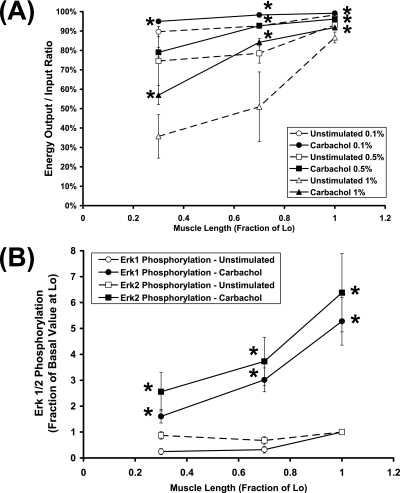Figure 5.
(A) Length dependencies of mechanical energy output/input ratios during sinusoidal length oscillation of unstimulated (open symbols) and carbachol-stimulated (solid symbols) muscle strips. In these experiments, the oscillatory frequency was 1 Hz, and the oscillatory amplitude was 0.1% Lo (circles), 0.5% Lo (squares), or 1% Lo (triangles). Mechanical energy input and output were calculated by integrating mechanical power input and output, respectively, with time during 10 cycles of length oscillation. Data are presented as means ± SEM (n = 3–7). *Significantly different from basal energy output/input ratio in unstimulated tissues held at the same muscle length (P < 0.05). (B) Length dependencies of extracellular signal-regulated kinase-1 (Erk1) phosphorylation (circles) and Erk2 phosphorylation (squares) in unstimulated (open symbols) and carbachol-stimulated (solid symbols) muscle strips. Labeling with anti-Erk1/2 antibody confirmed that the same amounts of Erk1 and Erk2 were loaded onto individual lanes (data not shown). Therefore, values of phospho-Erk1 and phospho-Erk2 reflect levels of Erk1/2 phosphorylation. In each experiment, the six samples derived from unstimulated and carbachol-stimulated muscle strips held at 0.3, 0.7, or 1.0 Lo were analyzed together by Western blotting. Concentrations of phospho-Erk1 or phospho-Erk2 in each sample were then normalized by the corresponding phospho-Erk1 and phospho-Erk2 concentrations in unstimulated muscle strips held at Lo, shown here as 1. *Significantly different from basal phosphorylation in unstimulated tissues held at the same muscle length. Data are presented as means ± SEM (n = 9).

